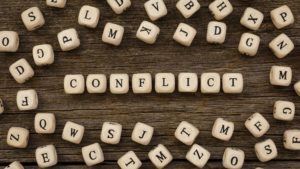News & Stories
Managing conflict
 “A distinguishing feature of our Leadership Development program is the diverse community of experienced coaches who make up the UNC Kenan-Flagler Coaches Forum. Created to provide a consistently high standard of coaching for our MBA students, it also encourages innovation in our Leadership Program. These insights are from one of our 45 coaches who bring their expertise to create best-in-class thought leadership on MBA coaching at UNC Kenan-Flagler.” Lisa Mashburn, Associate Director, Career & Leadership, MBA & Alumni
“A distinguishing feature of our Leadership Development program is the diverse community of experienced coaches who make up the UNC Kenan-Flagler Coaches Forum. Created to provide a consistently high standard of coaching for our MBA students, it also encourages innovation in our Leadership Program. These insights are from one of our 45 coaches who bring their expertise to create best-in-class thought leadership on MBA coaching at UNC Kenan-Flagler.” Lisa Mashburn, Associate Director, Career & Leadership, MBA & Alumni
Coaches’ Corner
One topic that has come up a lot in my coaching conversations with business students is conflict management. My first reaction is to ask questions about the context. When do you feel stressed out about interactions with others? Is it usually a specific situation or topic? Is there a pattern?
Then I move to questions about their experience. Imagine the last conflict situation you were I – what did you do? What happened? How did you feel? What might you do differently if you had the opportunity?
Finally, I move into questions about the possibilities. If you had no angst about conflict, what would you do in conflict situations? How does that make you feel? What do you think the outcome might be?
Many times what gets in the way of feeling comfortable about conflict is your mindset – that conflict is “bad” and a sign of a strained relationship. In reality, conflict is necessary because we each have our own ideas, and conflict is the clashing of ideas.
It’s how we handle conflict that matters. If we can share our ideas without disparaging another’s – if we can hold each other in positive regard – then we have healthy conflict.
A coaching technique I use at this stage is persona play. I ask my client to think of a person or character (from personal life, public life or fiction) who embodies the conflict style they would like to emulate. Then I ask them to don that persona – “put on the coat” of the character, if you will – when they find themselves in a conflict situation.
One client named her current persona “Meek Millie” and her desired persona “Fierce Frances.” She described Fierce Frances to me – what she looked like and how she behaved – and what it would feel like if she were Fierce Frances in the middle of a conflict situation. She sounded calm, confident and level-headed – and my client pictured herself in that role.
Sometimes, clients want more direction in handling conflict. In that case, I shift more into a performance coach role, giving direction more than asking introspective questions.
As part of the Coaches Forum at UNC Kenan-Flagler, a group of coaches pooled our collective knowledge on coaching topics into an online Coaches Resource Guide by topic. Some of our key points on managing conflict include:
- If the conflict is a communication breakdown, work on reflective listening to find common ground. Discuss not only the situation, but also your individual perspectives about the situation.
- Try to get underneath the position to get to the underlying interest.
- Use resources such as UNC Kenan-Flagler’s “SBIA” (Situation, Behavior, Impact, Action) Feedback model and the book “Crucial Conversations, among others.
In short, coaching around conflict usually involves exploring self-limiting beliefs AND finding resources that help pave a path to healthy conflict. It’s a skill that can really serve us well once we become comfortable with it. To quote author Patrick Lencioni, “Conflict is always the right thing to do when it matters.”
By Katherine Gilliland, Executive Coach at UNC Kenan-Flagler